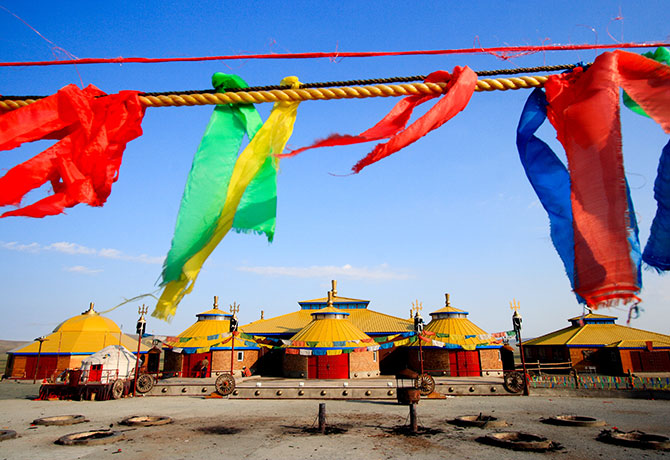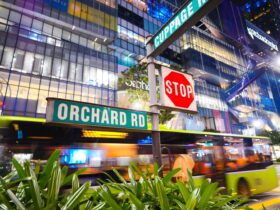Kai Tamin-Goh is surprised to discover how modern Inner Mongolia is and she shares her uncommon experiences with us
[dropcap]I[/dropcap]n my teens, I had romantic notions of Mongolia, fed by my history teacher’s stories of Genghis Khan’s conquests and the mystique of the deserts and grasslands.

I finally joined a Singapore tour group expecting to experience scenic Mongolian plains and real yurts (tents used by nomads) in the desert. My husband and I flew on China Airlines via Beijing and took another flight from there to start our tour from Hohhot, capital of Inner Mongolia.

Not Quite What’s Expected
In reality, Inner Mongolia is not quite what I expected. The capital, Hohhot, is like any bustling city with the usual fanfare of pedestrian and vehicular traffic, shopping malls and hotels.
Really, we could be anywhere in China. The cityscape is dotted with familiar brands – Shangri-La hotel, Starbucks, KFC, McDonald’s and Louis Vuitton. Singapore’s own Toastbox outlet is within walking distance of our hotel and Japanese retail giant Uniqlo was scheduled to open.
In contrast, on a more-than-1,200m-long commercial street in Hohhot, the buildings are built in Islamic design and colours. We saw signs of Muslim influence in the two mosques, a school, department stores, residences and restaurants there. Islamic Street is now a major tourist attraction.
Islam is said to have been introduced into Inner Mongolia during the Yuan Dynasty and most Muslims there are Hui Muslims (one of the recognised ethnic groups in China. However, the large majority of the population of Inner Mongolia adhere to old folk religion or shamanism.

Singing Sand in the Desert?
At the Xiangshawan Sand Gorge or Resonant Sand Gorge in Xiangshawan Desert, the highlight was the ‘singing’ sand. Also known as the Singing Sand Ravine, the sand is said to make echo sounds.
On the buggy ride on the sand dunes overlooking the vast expanse of Mongolian grassland, I failed to hear the whisper of the sands. Nonetheless, tourists who tried sand sliding swore that they heard a light “shhh” sound.
If the typical tourist fare of acrobatics on a tightrope or dance troupes offering entertainment is not your cup of tea, try sand sliding, riding a cable car or camel, or simply walking on the sand dunes.
Cloth shoe covers and face cloth ‘masks’ are available for 10 yuan apiece – and they are much needed for protection against the sand as the winds are strong. Before you go, remember to pack plenty of sunblock and a cap, and drink plenty of water as the weather there can be very dry.
All the yurts are designed like modern three-star hotels complete with attached showers and toilets, as well as flat-screen TV and working air-conditioners!

The Rolling Plains of the Mongols
Apart from the desert, the Xilamuren Grasslands are what draw tourists to Inner Mongolia. I pushed away any lingering notion of horse riding into the sunset or sleeping in a real Mongolian yurt. The grasslands are pitch black at night and all the yurts are designed like modern three-star hotels complete with attached showers and toilets, as well as flat-screen TV and working air-conditioners!
While offering comfort to pampered city folks, this luxury left some of us yearning for a real Mongolian experience. So much for a taste of the primitive nomadic life of the Mongols of medieval days!
As for Inner Mongolia’s so-called scenic grasslands, my group unanimously agrees that we had seen greener pastures. On the plus side, cool evenings were welcome respite from the merciless afternoon heat.
The enterprising Mongols offered ‘customised tours’ around the grassland by self-drive jeep or on a guided horse tour. My husband and I paid 400 yuan (S$80) per person for a one-and-a-half-hour horse ride.

Preparing For Inner Mongolia
Before heading for Inner Mongolia, make sure to pack extra batteries and bring your own battery chargers, adaptors and memory cards for your camera. If you will be travelling with older folks with knee or joint pain or other medical conditions, don’t forget to bring along whatever medication is needed.
While travelling outside Hohhot, bring (antiseptic) wet wipes even though squat-type public toilets are accessible and generally clean. You’ll never know when they’ll come in handy.
The best advice I can give you is to keep an open mind and moderate your expectations to get the most out of your holiday.
First-time visitors should also note that Inner Mongolia is in northern China, close to Shanxi province. It is different from Outer Mongolia, or simply Mongolia, which is landlocked between China and Russia, and is an independent parliamentary republic.
By Kai Tamin-Goh
ADVERTISEMENTS










Leave a Reply